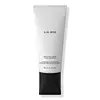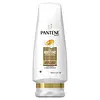What's inside
What's inside
 Key Ingredients
Key Ingredients

No key ingredients
 Benefits
Benefits

 Concerns
Concerns

 Ingredients Side-by-side
Ingredients Side-by-side

Lactobacillus/Arundinaria Gigantea Ferment Filtrate
Skin ConditioningSodium Cocoyl Isethionate
CleansingSodium Lauroyl Methyl Isethionate
CleansingCetearyl Alcohol
EmollientGlycerin
HumectantCocamidopropyl Betaine
CleansingLactobacillus Ferment
Skin ConditioningCetearyl Olivate
Helianthus Annuus Seed Oil
EmollientSalvia Hispanica Seed Extract
EmollientLactobacillus
Skin ConditioningSorbitan Olivate
EmulsifyingCitrus Limon Fruit Extract
MaskingCoco-Glucoside
CleansingVaccinium Myrtillus Fruit/Leaf Extract
AstringentBambusa Arundinacea Stem Extract
Skin ConditioningCladonia Rangiferina Extract
Skin ConditioningGlycosphingolipids
Emollient2,3-Butanediol
HumectantMentha Piperita Leaf Extract
Skin ConditioningZingiber Officinale Root Extract
MaskingCitrus Aurantium Dulcis Fruit Extract
MaskingAcer Saccharum Extract
Skin ConditioningSaccharum Officinarum Extract
MoisturisingPyrus Malus Fruit Extract
Skin ConditioningCharcoal Powder
AbrasivePisum Sativum Peptide
Skin ConditioningNiacinamide
SmoothingPanthenol
Skin ConditioningMedicago Sativa Extract
TonicCocos Nucifera Fruit Extract
EmollientGlycolic Acid
BufferingBetaine
HumectantLactobacillus Ferment Lysate
Skin ConditioningSaccharomyces/Copper Ferment
Skin ConditioningSaccharomyces/Iron Ferment
Skin ConditioningSaccharomyces/Magnesium Ferment
Saccharomyces/Zinc Ferment
Skin ConditioningBiotin
AntiseborrhoeicCaffeine
Skin ConditioningMelatonin
AntioxidantCamellia Sinensis Leaf Extract
AntimicrobialParfum
MaskingGuar Hydroxypropyltrimonium Chloride
Skin ConditioningHexapeptide-11
Skin ConditioningLinalool
PerfumingLimonene
PerfumingLactobacillus/Arundinaria Gigantea Ferment Filtrate, Sodium Cocoyl Isethionate, Sodium Lauroyl Methyl Isethionate, Cetearyl Alcohol, Glycerin, Cocamidopropyl Betaine, Lactobacillus Ferment, Cetearyl Olivate, Helianthus Annuus Seed Oil, Salvia Hispanica Seed Extract, Lactobacillus, Sorbitan Olivate, Citrus Limon Fruit Extract, Coco-Glucoside, Vaccinium Myrtillus Fruit/Leaf Extract, Bambusa Arundinacea Stem Extract, Cladonia Rangiferina Extract, Glycosphingolipids, 2,3-Butanediol, Mentha Piperita Leaf Extract, Zingiber Officinale Root Extract, Citrus Aurantium Dulcis Fruit Extract, Acer Saccharum Extract, Saccharum Officinarum Extract, Pyrus Malus Fruit Extract, Charcoal Powder, Pisum Sativum Peptide, Niacinamide, Panthenol, Medicago Sativa Extract, Cocos Nucifera Fruit Extract, Glycolic Acid, Betaine, Lactobacillus Ferment Lysate, Saccharomyces/Copper Ferment, Saccharomyces/Iron Ferment, Saccharomyces/Magnesium Ferment, Saccharomyces/Zinc Ferment, Biotin, Caffeine, Melatonin, Camellia Sinensis Leaf Extract, Parfum, Guar Hydroxypropyltrimonium Chloride, Hexapeptide-11, Linalool, Limonene
Water
Skin ConditioningCetyl Alcohol
EmollientStearamidopropyl Dimethylamine
EmulsifyingGlycerin
HumectantStearyl Alcohol
EmollientGlutamic Acid
HumectantBis-Aminopropyl Dimethicone
Sodium Chloride
MaskingPanthenol
Skin ConditioningPanthenyl Ethyl Ether
Histidine
HumectantParfum
MaskingDisodium EDTA
Citric Acid
BufferingPhenoxyethanol
PreservativeBenzyl Alcohol
PerfumingMethylchloroisothiazolinone
PreservativeMethylisothiazolinone
PreservativeWater, Cetyl Alcohol, Stearamidopropyl Dimethylamine, Glycerin, Stearyl Alcohol, Glutamic Acid, Bis-Aminopropyl Dimethicone, Sodium Chloride, Panthenol, Panthenyl Ethyl Ether, Histidine, Parfum, Disodium EDTA, Citric Acid, Phenoxyethanol, Benzyl Alcohol, Methylchloroisothiazolinone, Methylisothiazolinone
 Reviews
Reviews

Alternatives
Ingredients Explained
These ingredients are found in both products.
Ingredients higher up in an ingredient list are typically present in a larger amount.
Glycerin is already naturally found in your skin. It helps moisturize and protect your skin.
A study from 2016 found glycerin to be more effective as a humectant than AHAs and hyaluronic acid.
As a humectant, it helps the skin stay hydrated by pulling moisture to your skin. The low molecular weight of glycerin allows it to pull moisture into the deeper layers of your skin.
Hydrated skin improves your skin barrier; Your skin barrier helps protect against irritants and bacteria.
Glycerin has also been found to have antimicrobial and antiviral properties. Due to these properties, glycerin is often used in wound and burn treatments.
In cosmetics, glycerin is usually derived from plants such as soybean or palm. However, it can also be sourced from animals, such as tallow or animal fat.
This ingredient is organic, colorless, odorless, and non-toxic.
Glycerin is the name for this ingredient in American English. British English uses Glycerol/Glycerine.
Learn more about GlycerinPanthenol is a common ingredient that helps hydrate and soothe the skin. It is found naturally in our skin and hair.
There are two forms of panthenol: D and L.
D-panthenol is also known as dexpanthenol. Most cosmetics use dexpanthenol or a mixture of D and L-panthenol.
Panthenol is famous due to its ability to go deeper into the skin's layers. Using this ingredient has numerous pros (and no cons):
Like hyaluronic acid, panthenol is a humectant. Humectants are able to bind and hold large amounts of water to keep skin hydrated.
This ingredient works well for wound healing. It works by increasing tissue in the wound and helps close open wounds.
Once oxidized, panthenol converts to pantothenic acid. Panthothenic acid is found in all living cells.
This ingredient is also referred to as pro-vitamin B5.
Learn more about PanthenolParfum is a catch-all term for an ingredient or more that is used to give a scent to products.
Also called "fragrance", this ingredient can be a blend of hundreds of chemicals or plant oils. This means every product with "fragrance" or "parfum" in the ingredients list is a different mixture.
For instance, Habanolide is a proprietary trade name for a specific aroma chemical. When used as a fragrance ingredient in cosmetics, most aroma chemicals fall under the broad labeling category of “FRAGRANCE” or “PARFUM” according to EU and US regulations.
The term 'parfum' or 'fragrance' is not regulated in many countries. In many cases, it is up to the brand to define this term.
For instance, many brands choose to label themselves as "fragrance-free" because they are not using synthetic fragrances. However, their products may still contain ingredients such as essential oils that are considered a fragrance by INCI standards.
One example is Calendula flower extract. Calendula is an essential oil that still imparts a scent or 'fragrance'.
Depending on the blend, the ingredients in the mixture can cause allergies and sensitivities on the skin. Some ingredients that are known EU allergens include linalool and citronellol.
Parfum can also be used to mask or cover an unpleasant scent.
The bottom line is: not all fragrances/parfum/ingredients are created equally. If you are worried about fragrances, we recommend taking a closer look at an ingredient. And of course, we always recommend speaking with a professional.
Learn more about Parfum